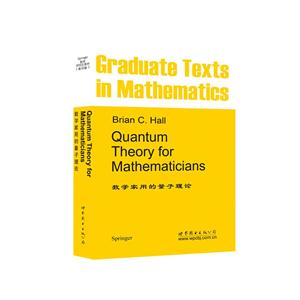数学家用的量子理论 版权信息
- ISBN:9787519203238
- 条形码:9787519203238 ; 978-7-5192-0323-8
- 装帧:一般胶版纸
- 册数:暂无
- 重量:暂无
- 所属分类:>>
数学家用的量子理论 本书特色
尽管量子物理思想在现代数学的许多领域发挥着重要的作用,但是针对数学家的量子力学书却几乎没有。该书用数学家熟悉的语言介绍了量子力学的主要思想。接触物理少的读者在会比较喜欢该书用会话的语调来讲述诸如用hibert空间法研究量子理论、一维空间的薛定谔方程、有界无界自伴算子的谱定理、ston-von neumann定理、wentzel-kramers-brillouin逼近、李群和李代数量子力学中的作用等
数学家用的量子理论 内容简介
尽管量子物理思想在现代数学的许多领域发挥着重要的作用,但是针对数学家的量子力学书却几乎没有。《数学家用的量子理论(英文版)》用数学家熟悉的语言介绍了量子力学的主要思想。接触物理少的读者在会比较喜欢《数学家用的量子理论(英文版)》用会话的语调来讲述诸如用Hibert空间法研究量子理论、一维空间的薛定谔方程、有界无界自伴算子的谱定理、Ston-vonNeumann定理、Wentzel-Kramers-Brillouin逼近、李群和李代数量子力学中的作用等。
数学家用的量子理论 目录
1 The Experimental Origins of Quantum Mechanics1.1 Is Light a Wave or a Particle?
1.2 Is an Electron a Wave or a Particle?
1.3 SchrSdinger and Heisenberg1.4 A Matter of Interpretation1.5 Exercises2 A First Approach to Classical Mechanics2.1 Motion in R12.2 Motion in Rn2.3 Systems of Particles2.4 Angular Momentum2.5 Poisson Brackets and Hamiltonian Mechanics2.6 The Kepler Problem and the Runge-Lenz Vector2.7 Exercises3 A First Approach to Quantum Mechanics3.1 Waves, Particles, and Probabilities3.2 A Few Words About Operators and Their Adjoints3.3 Position and the Position Operator3.4 Momentum and the Momentum Operator3.5 The Position and Momentum Operators3.6 Axioms of Quantum Mechanics: Operators and Measurements3.7 Time-Evolution in Quantum Theory3.8 The Heisenberg Picture3.9 Example: A Particle in a Box3.10 Quantum Mechanics for a Particle in Rn3.11 Systems of Multiple Particles3.12 Physics Notation3.13 Exercises4 The Free Schrodinger Equation4.1 Solution by Means of the Fourier Transform4.2 Solution as a Convolution4.3 Propagation of the Wave Packet: First Approach4.4 Propagation of the Wave Packet: Second Approach4.5 Spread of the Wave Packet4.6 Exercises5 A Particle in a Square Well5.1 The Time-Independent SchrSdinger Equation5.2 Domain Questions and the Matching Conditions5.3 Finding Square-Integrable Solutions5.4 Tunneling and the Classically Forbidden Region5.5 Discrete and Continuous Spectrum5.6 Exercises6 Perspectives on the Spectral Theorem6.1 The Difficulties with the Infinite-Dimensional Case6.2 The Goals of Spectral Theory6.3 A Guide to Reading6.4 The Position Operator6.5 Multiplication Operators6.6 The Momentum Operator7 The Spectral Theorem for Bounded Self-Adjoint Operators: Statements7.1 Elementary Properties of Bounded Operators7.2 Spectral Theorem for Bounded Self-Adjoint Operators, I7.3 Spectral Theorem for Bounded Self-Adjoint Operators, II7.4 Exercises8 The Spectral Theorem for Bounded Self-Adjoint Operators: Proofs8.1 Proof of the Spectral Theorem, First Version8.2 Proof of the Spectral Theorem, Second Version8.3 Exercises9 Unbounded Self-Adjoint Operators9.1 Introduction9.2. Adjoint and Closure of an Unbounded Operator9.3 Elementary Properties of Adjoints and Closed Operators9.4 The Spectrum of an Unbounded Operator9.5 Conditions for Self-Adjointness and Essential Self-Adjointness9.6 A Counterexample9.7 An Example9.8 The Basic Operators of Quantum Mechanics9.9 Sums of Self-Adjoint Operators9.10 Another Counterexample9.11 Exercises10 The Spectral Theorem for Unbounded Self-Adjoint Operators10.1 Statements of the Spectral Theorem10.2 Stone's Theorem and One-Parameter Unitary Groups10.3 The Spectral Theorem for Bounded Normal Operators10.4 Proof of the Spectral Theorem for Unbounded Self-Adjoint Operators10.5 Exercises11 The Harmonic Oscillator11.1 The Role of the Harmonic Oscillator11.2 The Algebraic Approach11.3 The Analytic Approach11.4 Domain Conditions and Completeness11.5 Exercises12 The Uncertainty Principle12.1 Uncertainty Principle, First Version12.2 A Counterexample12.3 Uncertainty Principle, Second Version12.4 Minimum Uncertainty States12.5 Exercises13 Quantization Schemes for Euclidean Space13.1 Ordering Ambiguities13.2 Some Common Quantization Schemes13.3 The Weyl Quantization for R2n13.4 The \"No Go\" Theorem of Groenewold13.5 Exercises14 The Stone-yon Neumann Theorem14.1 A Heuristic Argument14.2 The Exponentiated Commutation Relations14.3 The Theorem14.4 The Segal-Bargmann Space14.5 Exercises15 The WKB Approximation15.1 Introduction15.2 The Old Quantum Theory and the Bohr-Sommerfeld Condition15.3 Classical and Semiclassical Approximations15.4 The WKB Approximation Away from the Turning Points15.5 The Airy Function and the Connection Formulas15.6 A Rigorous Error Estimate15.7 Other Approaches15.8 Exercises16 Lie Groups, Lie Algebras, and Representations16.1 Summary16.2 Matrix Lie Groups16.3 Lie Algebras16.4 The Matrix Exponential16.5 The Lie Algebra of a Matrix Lie Group16.6 Relationships Between Lie Groups and Lie Algebras16.7 Finite-Dimensional Representations of Lie Groups and Lie Algebras16.8 New Representations from Old16.9 Infinite-Dimensional Unitary Representations16.10 Exercises17 Angular Momentum and Spin17.1 The Role of Angular Momentum in Quantum Mechanics17.2 TheAngular Momentum Operators in R317.3 Angular Momentum from the Lie Algebra Point of View17.4 The Irreducible Representations of so(3)17.5 The Irreducible Representations of S0(3)17.6 Realizing the Representations Inside L2(S2)17.7 Realizing the Representations Inside L2(~3)17.8 Spin17.9 Tensor Products of Representations: \"Addition of Angular Momentum\"17.10 Vectors and Vector Operators17.11 Exercises18 Radial Potentials and the Hydrogen Atom18.1 Radial Potentials18.2 The Hydrogen Atom: Preliminaries18.3 The Bound States of the Hydrogen Atom18.4 The Runge-Lenz Vector in the Quantum Kepler Problem18.5 The Role of Spin18.6 Runge-Lenz Calculations18.7 Exercises19 Systems and Subsystems, Multiple Particles19.1 Introduction19.2 Trace-Class and Hilbert Schmidt Operators19.3 Density Matrices: The General Notion of the State of a Quantum System19.4 Modified Axioms for Quantum Mechanics19.5 Composite Systems and the Tensor Product19.6 Multiple Particles: Bosons and Fermions19.7 \"Statistics\" and the Pauli Exclusion Principle19.8 Exercises20 The Path Integral Formulation of Quantum Mechanics20.1 Trotter Product Formula20.2 Formal Derivation of the Feynman Path Integral20.3 The Imaginary-Time Calculation20.4 The Wiener Measure20.5 The Feynman-Kac Formula20.6 Path Integrals in Quantum Field Theory20.7 Exercises21 Hamiltonian Mechanics on Manifolds21.1 Calculus on Manifolds21.2 Mechanics on Symplectic Manifolds21.3 Exercises22 Geometric Quantization on Euclidean Space22.1 Introduction22.2 Prequantization22.3 Problems with Prequantization22.4 Quantization22.5 Quantization of Observables22.6 Exercises23 Geometric Quantization on Manifolds23.1 Introduction23.2 Line Bundles and Connections23.3 Prequantization23.4 Polarizations23.5 Quantization Without Half-Forms23.6 Quantization with Half-Forms: The Real Case23.7 Quantization with Half-Forms: The Complex Case23.8 Pairing Maps23.9 ExercisesA Review of Basic MaterialA.1 Tensor Products of Vector SpacesA.2 Measure TheoryA.3 Elementary Fumctional AnalysisA.4 Hilbert Spaces and Operators on ThemReferencesIndex
展开全部
数学家用的量子理论 作者简介
Brian C. Hall(B.C. 霍尔,美国)是国际知名学者,在数学界享有盛誉。本书凝聚了作者多年科研和教学成果,适用于科研工作者、高校教师和研究生。





















